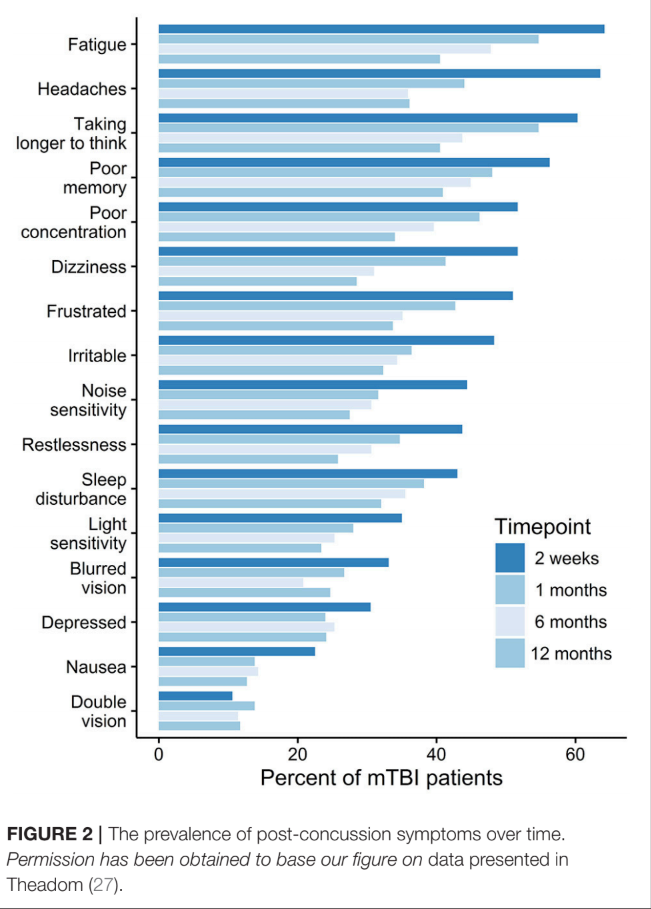Breathe your way to concussion recovery?
Biofeedback in concussion.
Roughly 10-25% of people who experience mild traumatic brain injury (mTBI), or concussion, will experience post-concussion symptoms that persist over time. That's almost 1 in 4 people who sustain a concussion. If you fall into this category of post-concussion symptoms last longer than three months, you may have been told you have (the controversial diagnosis of) post-concussive syndrome (PCS).
Many of the most common lingering symptoms include:
Fatigue
Headache
Taking longer to think
Poor memory/concentration
Dizziness
Frustration/irritability
Etc.
You can see (graph) that approximately 10-35% of post-concussive patients experience symptoms to at least 12 months post-concussion.
While it is undoubtedly a dynamic and multifactorial process (e.g., biologic, psychiatric, social, etc.) that determines who recovers and who suffers after a concussion, the question remains; is there a non-invasive and drug-free way to improve symptoms, recovery, and quality of life?
There is growing research saying, "Probably."
One VERY accessible option: Heart Rate Variability (HRV) Biofeedback
"Bigler (2008) points out that a concussion from a football tackle, automobile accident or blast injury does not solely affect the brain. The concussive forces can affect all organs, including the heart (Cernak and Noble-Haeusslein, 2009)."
The autonomic nervous system highly regulates our cardiovascular system. The autonomic nervous system houses our sympathetic nervous system ("fight or flight") and our parasympathetic nervous system ("rest and digest"). And heart rate variability is a non-invasive way to monitor your heart, and by proxy monitor your brain and autonomic nervous system.
Heart rate variability (HRV) is the change in your heart rate from beat-to-beat. Typically, your heart rate SHOULD be variable. When HRV is lower, we see strong correlations with cardiovascular morbidity and mortality. When HRV is higher, we see a more robust cardiovascular system - AND a healthier emotional and cognitive nervous system.
Even niftier, is that we have some data shows electroencephalography (EEG) may correlate with HRV. And this makes sense because it's thought that HRV is likely highly regulated by our frontal lobes that also control attention, thought, and emotion. If you remember back to the top of the article, "attention, thought, and emotion" are some of the most affected functions in post-concussive states.
Now, I know this sounds like alphabet soup at this point.
Here's the takeaway, we can train HRV just like train muscles in the gym. The better (higher) your HRV, the better your cardiovascular and nervous systems function together. This means better brain blood flow, improved thought processing, improved cognition, and improve emotional regulation.
How do we train our HRV?
My two favorite ways: aerobic exercise and breathing.
Aerobic Exercise
I wrote an article here, where you can see the best aerobic exercise intensities for optimizing brain circulation and oxygen delivery.
This, in theory, has the potential to improve brain functions, and, in research, has been shown to improve HRV - which, in research, has been shown to improve brain functions. Win-Win.
Breathing with biofeedback.
If you want to get stronger, you create an artificial environment that demands strength (e.g., lift heavy weights a few times per week). If you're going to get faster, you create an artificial environment that requires speed (e.g., sprint work a few times per week).
Well if you want to improve your HRV, you train to maintain a higher HRV state. Research shows that paced breathing can increase heart rate variability, and breathing rates between 4.5 and 6.5 breaths per minute will produce the greatest HRV in most individuals. (Clinically, many people aim for 6 breaths per minute.)
My favorite tool for myself, and that I use with patients is Inner Balance by Heart Math. I receive no funds or kickbacks for mentioning their name; I do simply use and enjoy their product. This tool is a sensor that clips gently to your ear to measure your heart rate variability and can score your HRV.
My personal HRV and Coherence Scores from a recent paced breathing session with Inner Balance. Ideally, my HRV (the blue line at the bottom) should look like a smooth sine wave. Additionally, my coherence over time (the top graph) should have the line in the green 85% of the time or more. This indicates a smooth and coherent heart-brain state. That’s the state, that when practiced, leads to positive and noticeable changes.
The goal is to maintain a high coherence (e.g., having the breath, heart, and brain all synching up together). Additionally, there is visual and auditory feedback that lets you know when you are in good coherence compared to poorer coherence.
Similar to how a coach can give you feedback about your exercise technique and how a movement should feel. The Inner Balance app is giving you feedback about your autonomic nervous system and how high coherence (e.g. a good heart-brain state) should feel. By receiving this feedback, you can now train/exercise your HRV to maintain higher coherence levels more consistently throughout the day, from day-to-day.
This has been shown to translate to decreased PCS symptoms, improved emotional states, and improved cognitive capabilities - all from sitting and breathing with feedback.
Hooray for simplicity!
Our brain's ability to adapt (neuroplasticity) is a fantastic thing. Training HRV is just one of the many ways that we can capitalize on that "power." By doing so, we enhance recovery, are proactive in prevention, and optimize your performance in sport and life.
References:
Conder, R. L., & Conder, A. A. (2014). Heart rate variability interventions for concussion and rehabilitation. Frontiers in psychology, 5, 890.
Paniccia, M., Verweel, L., Thomas, S., Taha, T., Keightley, M., Wilson, K. E., & Reed, N. (2018). Heart rate variability in healthy non-concussed youth athletes: exploring the effect of age, sex, and concussion-like symptoms. Frontiers in neurology, 8, 753.
Polinder, S., Cnossen, M. C., Real, R. G., Covic, A., Gorbunova, A., Voormolen, D. C., ... & van Steinbuechel, N. (2018). A multidimensional approach to post-concussion symptoms in mild traumatic brain injury: A focused review. Frontiers in neurology, 9, 1113.




